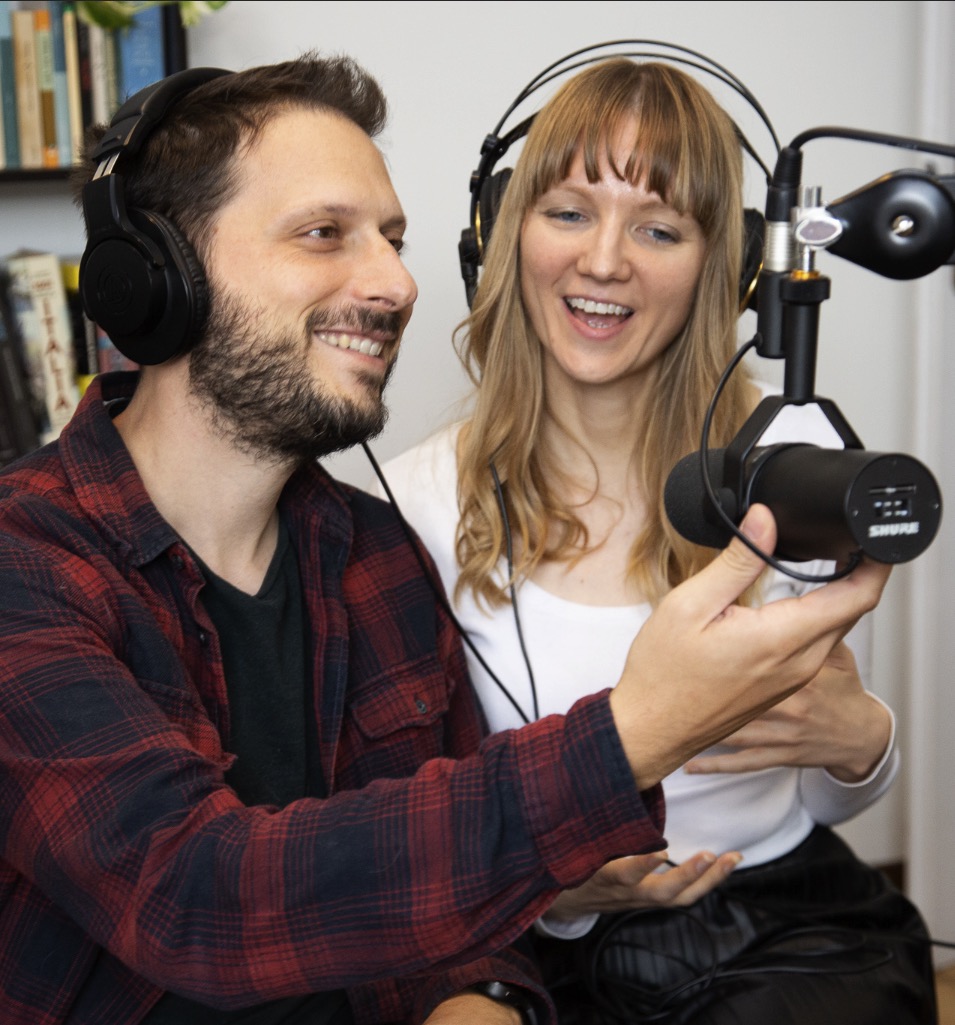What should you do when a friend forgets his wallet? Find out what Matteo does, and learn how to use that tricky little word “gli” in episode #56 of 5 Minute Italian.
To help you remember what you learnt in today's lesson, below you'll find bonus materials including word lists, quizzes and flashcards. But first...
Become a 5-minute Italian member (it's free!)
Learn to speak and understand Italian faster by joining the 5 minute Italian club! When you sign up, you'll get:
- Mini Italian lessons + bonus materials delivered to your inbox.
- Access to the private Facebook group where you can practice chatting in Italian.
- Invites to free speaking workshops.
If you'd like to join us, click here to become a member of 5 Minute Italian.
Today's Italian words
Che cosa fai quando un amico ha bisogno di aiuto? = What do you do when a friend needs help?
Che cosa = what
Fai = you do
Quando = when
Un amico = a friend
Ha bisogno di = needs (literally “has need of”)
Aiuto = help
Gli do una mano = I give him a hand.
Gli = To him
Do = I give
Una mano = A hand
Gli dico = I say to him (Literally: to him, I say)
Che cosa gli dico? = What shall I say to him? (literally: What, to him, I say?)
Gli cucino = I cook for him (For him, I cook)
Quando dimentica il portafoglio? = When he forgets his wallet?
Quando = when
Dimentica = he forgets
il portafoglio = the wallet?
Gli dico che non c’è problema e gli pago la cena = I tell him it’s not a problem and I pay for his dinner.
Gli = to him
Dico = I say
Che = that
Non c’è = there isn’t
Problema = a problem
Non c’è problema = no problem/no worries
e = and
Gli = for him
Pago = I pay
La cena = the dinner
Quando ha fame? = When he’s hungry?
Quando = when
Ha = he has
Fame = hunger
Gli cucino qualcosa = I cook something for him
Gli = for him
Cucino = I cook
Qualcosa = something
Quando è stanco?
When he’s tired?
Quando = when
È = he is
Stanco = tired
Gli offro un caffè = I offer him a coffee.
Gli = to him
Offro = I offer
Un caffè = a coffee
Tu si che sei un buon amico! = You’re such a good friend!
I give to him = Gli do
Gli dico = I say to him
More examples with "gli"
| Verb | Example |
| Dire
To say | Che cosa gli dico?
What shall I say to him? (Literally: What to him I say?) |
| Dare
To give | Gli ho dato il mio numero
I gave him my number (Literally: To him, I gave my number) |
| Offrire
To offer | Gli offro una birra
I offer him a beer (Literally: To him, I offer a beer) |
| Parlare
To talk | Gli parlo tutti i giorni
I talk to him every day (Literally: To him, I speak every the days) |
| Portare
To bring/take | Gli porto un caffè
I bring/take him a coffee (Literally: To him, I take a coffee) |
| Fare
To make/do | Gli faccio un caffè
I make him a coffee (Literally: for him, I make a coffee) |
| Scrivere
To write | Gli scrivo una lettera
I write a letter to him (Literally: to him, I write a letter) |
| Prestare
To lend | Gli presto un libro
I lend him a book (Literally: to him, I lend a book) |
Take the Quiz!
How much did you learn? Find out in the 5-minute Italian quiz!
Click here to take the quiz for this episode: How to use "gli" (to him, for him)
Italian flashcards
Remember the vocabulary from your 5 Minute Italian lessons by downloading the digital flashcard pack.
- Download the flashcards: How to use gli in Italian (to him, for him).
- Not sure how it works? Click here to watch the tutorial.
Become a 5-minute Italian member (it's free!)
Learn to speak and understand Italian faster by joining the 5 minute Italian club! When you sign up, you'll get:
- Mini Italian lessons + bonus materials delivered to your inbox.
- Access to the private Facebook group where you can practice chatting in Italian.
- Invites to free speaking workshops.
If you'd like to join us, click here to become a member of 5 Minute Italian.
Transcript
Please note, this is not a word for word transcript.
Katie: Ciao a tutti e benvenuti a 5 Minute Italian, I’m Katie.
Matteo: And I’m Matteo.
K: Today, we’re talking about a very important and sometimes confusing word “gli”. Before we get into it, remember to head our website where you’ll find bonus materials for this lesson including a quiz, flashcards and a transcript to help remember what you learnt today. Go to joyoflanguages.com/italianpodcast and scroll down to episode #56
Matteo: For now, ascoltiamo la conversazione (let’s listen to the conversation).
Katie: Che cosa fai quando un amico ha bisogno di aiuto?
Matteo: Gli do una mano.
Katie: Quando dimentica il portafoglio?
Matteo: Gli dico che non c’è problema e gli pago la cena
Katie: Quando ha fame?
Matteo: Gli cucino qualcosa.
Katie: Quando è stanco?
Matteo: Gli offro un caffè.
Katie: Tu si che sei un buon amico!
K: So I asked Matteo:
M: Che cosa fai quando un amico ha bisogno di aiuto?
K: What do you do when a friend needs help? Word for word, that’s:
M:
Che cosa = what
Fai = you do
Quando = when
Un amico = a friend
Ha bisogno di = needs (literally “has need of”)
Aiuto = help
K: And Matteo’s reply was:
M: Gli do una mano
K: I give him a hand. This expression exists in Italian too! Literally
M:
Gli = To him
Do = I give
Una mano = A hand
K: And here we’ve got our first example of the word “gli” which means “to him” or “for him”. Notice that in English, we sometimes cut out the “to”. So we can say “give a present to your brother” or “give your brother a present”. The key thing to know is that if there is the possibility to use “to him” or “for him” in English, you will probably need to use “gli” in Italian. And we say it backwards in Italian. So “I give him is.”
M: Gli do
K: Literally “to him, I give”.
K: Other examples are: “I say to him”
M: Gli dico
K: “to him, I say”
A very common phrase you will hear in Italian is:
M: “Che cosa gli dico?”
K: What shall I say to him? (literally: What, to him, I say?)
K: I cook for him
M: Gli cucino
K: For him, I cook
K: And you’ll hear more examples in the rest of the conversation. I asked Matteo...
M: Quando dimentica il portafoglio?
K: When he forgets his wallet? Literally:
M:
Quando = when
Dimentica = he forgets
il portafoglio = the wallet?
K: Matteo replied:
M: Gli dico che non c’è problema e gli pago la cena.
K: I tell him it’s not a problem and I pay for his dinner. Let’s break that down:
M:
Gli = to him
Dico = I say
Che = that
Non c’è = there isn’t
Problema = a problem
K: This is a useful phrase to learn “non c’è problema” (literally “there’s no problem”). You can use it when you want to say “no problem” or “no worries”.
M: Non c’è problema
K: Let’s finish the phrase
M:
e = and
gli = for him
pago = I pay
la cena = the dinner
K: In Italian, to say “I pay for his dinner” we literally say “for him, I pay the dinner” Gli pago la cena. Next, I asked Matteo:
M: Quando ha fame?
K: When he’s hungry? Literally:
M:
Quando = when
Ha = he has
Fame = hunger
K: And Matteo replied:
M: Gli cucino qualcosa
K: I cook something for him
M:
Gli = for him
Cucino = I cook
Qualcosa = something
K: Next, I asked:
M: Quando è stanco?
K: When he’s tired?
M:
Quando = when
È = he is
Stanco = tired
K: Then Matteo replied:
M: Gli offro un caffè
K: I offer him a coffee.
M:
Gli = to him
Offro = I offer
Un caffè = a coffee
Katie: Finally, you heard me say:
Matteo: Tu si che sei un buon amico!
Katie: You’re such a good friend! This structure “tu si che sei” is a way of adding emphasis. I can say “you’re a good friend”.
M: “Sei un buon amico”
K: But if I add “tu si che” it’s a bit like saying “you’re such a” in English.
M: Tu si che sei un buon amico.
K: Alright, before we go, a couple more things about “gli”. Firstly the most common words you’ll hear “gli” with are “dare” (to give) and “dire” (to say). So if you only remember two things from today’s lesson, remember these two phrases.
K: I give to him
M: Gli do
K: I say to him
M: Gli dico
K: Those two little phrases will take you a long way towards using “gli” correctly.
So we learnt “to him” or “for him”. Next time, you'll learn "to them" and I'll give you a hint, it'll be quite easy if you've already done this lesson! For now, let’s listen to the conversation again:
Katie: Che cosa fai quando un amico ha bisogno di aiuto?
Matteo: Gli do una mano.
Katie: Quando dimentica il portafoglio?
Matteo: Gli dico che non c’è problema e gli pago la cena
Katie: Quando ha fame?
Matteo: Gli cucino qualcosa.
Katie: Quando è stanco?
Matteo: Gli offro un caffè.
Katie: Tu si che sei un buon amico!
K: There are many other words that use “gli” in Italian. If you want to learn more, you’ll find a table of these with example sentences, by heading over on our website joyoflanguages.com/Italianpodcast and scrolling down to episode 56.
Ciao for now, or as we say in Italian.
M: Alla prossima!
Get more 5-minute Italian
To get more 5 minute Italian, including lessons delivered to your inbox, access to the private Facebook group and invites to speaking workshops, click here to become a 5 Minute Italian member.
Related episodes
#5: How to pronounce the Italian "gli"; like in famiglia
#53: Direct object pronouns in Italian: Mi, Ti, Lo, La, Ci, Vi, Li, Le

